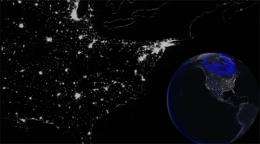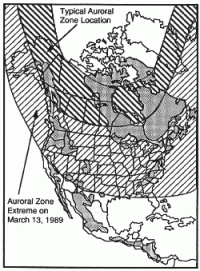The Day the Sun Brought Darkness (w/Video)

On March 13, 1989 the entire province of Quebec, Canada suffered an electrical power blackout. Hundreds of blackouts occur in some part of North America every year. The Quebec Blackout was different, because this one was caused by a solar storm!
On Friday March 10, 1989 astronomers witnessed a powerful explosion on the sun. Within minutes, tangled magnetic forces on the sun had released a billion-ton cloud of gas. It was like the energy of thousands of nuclear bombs exploding at the same time. The storm cloud rushed out from the sun, straight towards Earth, at a million miles an hour. The solar flare that accompanied the outburst immediately caused short-wave radio interference, including the jamming of radio signals from Radio Free Europe into Russia. It was thought that the signals had been jammed by the Kremlin, but it was only the sun acting up!
On the evening of Monday, March 12 the vast cloud of solar plasma (a gas of electrically charged particles) finally struck Earth's magnetic field. The violence of this 'geomagnetic storm' caused spectacular 'northern lights' that could be seen as far south as Florida and Cuba. The magnetic disturbance was incredibly intense. It actually created electrical currents in the ground beneath much of North America. Just after 2:44 a.m. on March 13, the currents found a weakness in the electrical power grid of Quebec. In less than 2 minutes, the entire Quebec power grid lost power. During the 12-hour blackout that followed, millions of people suddenly found themselves in dark office buildings and underground pedestrian tunnels, and in stalled elevators. Most people woke up to cold homes for breakfast. The blackout also closed schools and businesses, kept the Montreal Metro shut during the morning rush hour, and closed Dorval Airport.
The Quebec Blackout was by no means a local event. Some of the U.S. electrical utilities had their own cliffhanger problems to deal with. New York Power lost 150 megawatts the moment the Quebec power grid went down. The New England Power Pool lost 1,410 megawatts at about the same time. Service to 96 electrical utilities in New England was interrupted while other reserves of electrical power were brought online. Luckily, the U.S. had the power to spare at the time…but just barely. Across the United States from coast to coast, over 200 power grid problems erupted within minutes of the start of the March 13 storm. Fortunately none of these caused a blackout.

In space, some satellites actually tumbled out of control for several hours. NASA's TDRS-1 communication satellite recorded over 250 anomalies as high-energy particles invaded the satellite's sensitive electronics. Even the Space Shuttle Discovery was having its own mysterious problems. A sensor on one of the tanks supplying hydrogen to a fuel cell was showing unusually high pressure readings on March 13. The problem went away just as mysteriously after the solar storm subsided.
Twenty years later, the March 1989 'Quebec Blackout' has reached legendary stature, at least among electrical engineers and space scientists. It is a dramatic example of how solar storms can affect us even here on the ground. Fortunately, storms as powerful as this are rather rare. It takes quite a solar wallop to cause anything like the conditions leading up to a Quebec-style blackout. Typical solar activity 'sunspot' cycles can produce least two or three large storms, so it really is just a matter of chance whether one will cause a blackout or not. As it is for hurricanes and tornadoes, the more we can learn about the sun's 'space weather,' the better we can prepare for the next storm when it arrives!
Source: ADNET/Catholic University/NASA


















